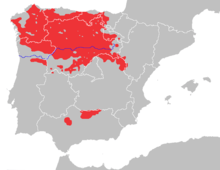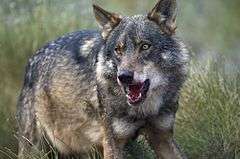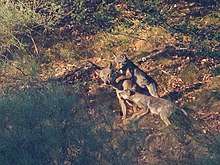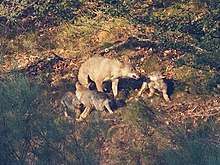Iberian wolf
| Iberian wolf | |
|---|---|
 | |
| Scientific classification | |
| Kingdom: | Animalia |
| Phylum: | Chordata |
| Class: | Mammalia |
| Order: | Carnivora |
| Family: | Canidae |
| Genus: | Canis |
| Species: | C. lupus |
| Subspecies: | C. l. signatus |
| Trinomial name | |
| Canis lupus signatus | |
 | |
The Iberian wolf (Canis lupus signatus Cabrera 1907) is a proposed subspecies of grey wolf that inhabits the northwest of the Iberian Peninsula, which includes northern Portugal and northwestern Spain. It is home to 2,200-2,500 wolves which have been isolated from mixing with other wolf populations for over a century. These form the largest wolf population in Western Europe.[3]
Taxonomy
The Iberian wolf Canis lupus signatus Cabrera 1907[2] is classified as Canis lupus lupus by Mammal Species of the World.[4] Some authors claim that the south-eastern Spanish wolf, last sighted in Murcia in the 1930s, was a different subspecies called Canis lupus deitanus. It was even smaller and more reddish in color, without dark spots. Both subspecies were nominated by the Spanish-born zoologist Ángel Cabrera in 1907.
The Iberian wolf's skull morphometrics, mtDNA, and microsatellites differ from other European wolves.[5] In 2016, a study of mitochondrial DNA sequences of both modern and ancient wolves indicated that in Europe, the two most genetically distinct haplotypes form the Italian wolf, and separately, the Iberian wolf.[6] The National Center for Biotechnology Information/Genbank lists the Iberian wolf under Canis lupus signatus.[7]
Description



Cabrera identified two types of wolves living in Spain. In comparison, C. l. lupus had a pale, undefined stroke on the cheek that contrasts with the white on the throat; C. l. signatus had a white stroke on the cheek that joins the white throat and with a reddish snout; and C. l. deitanus was much smaller and with more colouring than the wolves to the north. C. l. signatus is described as being 123 cm in head and body length, and 70 cm height at the shoulders.[2]
The Iberian wolf differs from the more common Eurasian wolf with its slighter frame, white marks on the upper lips, the dark marks on the tail, and a pair of dark marks in its front legs that give it its subspecies name, signatus ("marked"). The subspecies differentiation may have developed at the end of the Pleistocene Ice Ages due to the isolation of the Iberian Peninsula when glacier barriers grew in the Pyrenees and eventually reached the Gulf of Biscay in the west and the Mediterranean in the east.
Males can weigh up to 50 kg, with females usually weighing between 30 and 40 kg.[8]
Diet
The Iberian wolf lives in small packs. It is considered to be beneficial because it keeps the population of wild boars stable, thus allowing some respite to the endangered capercaillie populations which suffer greatly from boar predation.[9] It also eats rabbits, roe deer, red deer, ibexes and even small carnivores and fish. In some places, it eats domestic animals such as sheep and dogs.
Distribution and conservation
Wolf populations strongly declined across Europe during the 18th and 19th centuries largely due to human persecution, and by the end of the Second World War they had been eradicated from all of Central Europe and almost all of Northern Europe. Their population decline continued until the 1960s, with isolated populations surviving in Italy, Spain, Portugal, Greece, and Finland. Wolf populations have commenced recovering naturally since then.[10]
The Iberian wolf consists of over 2,000 individuals in over 350 packs distributed across 140,000 km. Their densities in some regions are among the highest in Europe, with up to 7 wolves/100 km2. In 2018, a study identified that this wolf could be categorised into 11 genetic groups. Four groups were identified in the Portuguese regions of Alto Minho, western Trás-os-Montes, eastern Trás-os-Montes, and one group located south of the Douro river. Seven groups were identified in the Spanish regions of western Galicia, eastern Galicia, western Asturias, central Asturias, easten Asturias, south-eastern Asturias, and Castilla y León.[11]
In Portugal, the populations are small due to the destruction of habitat, loss of wild ungulates and the persecution by humans.[12]
Some Spanish naturalists and conservationists such as Félix Rodríguez de la Fuente called for the end of the hunting and the protection of the animal. Today, the hunting of wolves is banned in Portugal, but allowed in some parts of Spain. The 2003 census estimated the total Iberian population to be 2,000 wolves.[13] Wolves have been reported as returning to Navarre and the Basque Country and to the provinces of Extremadura, Madrid, and Guadalajara. A male wolf was found recently in Catalonia, where the last native wolf was killed in 1929. However, this animal was not a member of the Iberian subspecies, but an Italian wolf (C. l. italicus) migrating from France. As of 2013, an estimated 300 individuals remain in Portugal.[14]
In October 2013, Ecologists in Action called for an urgent review of the Iberian wolf census, which may overestimate their numbers.[15] Later that month, wolf association Lobo Marley sent 198,000 signatures calling for the animal's protection to the European Parliament Committee on Petitions.[16] Over a few weeks in September and October 2013, about 30 puppies and young wolves were killed by hunters in Asturias, León, and Cantabria.[13]
Although hunting is banned in Portugal, about 45% of wolf deaths are due to human activities, including illegal hunting.[14] Calling the rate unsustainable, 10 organisations signed a statement requesting stronger protection.[14]
Southern population
Sierra Morena is a system of rugged mountain ranges in the south of the Iberian Peninsula where a very small wolf population has lived in isolation for half a century. A breeding pair of wolves was last sighted in 2013, however an extensive survey in 2016 could not find a breeding population. The DNA of a road-killed wolf from 2003 indicated high levels of inbreeding and 30% of the genome being that of dog. It is thought that as the population of these wolves declined, the inability to find a mate led to inbreeding and hybridization with dogs. The wolves in this region may now be extinct.[3]
References
- ↑ Large Carnivore Initiative for Europe (2007). "Canis lupus". IUCN Red List of Threatened Species. Version 3.1 (3.1). International Union for Conservation of Nature.
- 1 2 3 Cabrera A (1907). "Los lobos de Espana" [The wolves of Spain]. Boletín de la Real Sociedad Española de Historia Natural (in Spanish). VII: 193–198.
- 1 2 Gómez-Sánchez, Daniel; Olalde, Iñigo; Sastre, Natalia; Enseñat, Conrad; Carrasco, Rafael; Marques-Bonet, Tomas; Lalueza-Fox, Carles; Leonard, Jennifer A; Vilà, Carles; Ramírez, Oscar (2018). "On the path to extinction: Inbreeding and admixture in a declining grey wolf population". Molecular Ecology. 27 (18): 3599–3612. doi:10.1111/mec.14824. PMID 30074659.
- ↑ Wozencraft, W.C. (2005). "Order Carnivora". In Wilson, D.E.; Reeder, D.M. Mammal Species of the World: A Taxonomic and Geographic Reference (3rd ed.). Johns Hopkins University Press. pp. 575–577. ISBN 978-0-8018-8221-0. OCLC 62265494. p. 576, p. 577
- ↑ Ramírez, Oscar; Altet, Laura; Enseñat, Conrad; Vilà, Carles; Sànchez, Armand; Ruiz, Alfredo (November 2006). "Genetic assessment of the Iberian wolf Canis lupus signatus captive breeding program". Conservation Genetics: 861–878. doi:10.1007/s10592-006-9123-z. Retrieved 2015-06-02.
- ↑ Ersmark, Erik; Klütsch, Cornelya F. C.; Chan, Yvonne L.; Sinding, Mikkel-Holger S.; Fain, Steven R.; Illarionova, Natalia A.; Oskarsson, Mattias; Uhlén, Mathias; Zhang, Ya-Ping; Dalén, Love; Savolainen, Peter (2016). "From the Past to the Present: Wolf Phylogeography and Demographic History Based on the Mitochondrial Control Region". Frontiers in Ecology and Evolution. 4. doi:10.3389/fevo.2016.00134.
- ↑ "Canis lupus signatus". Taxonomy Browser. NCBI.
- ↑ "Lobo ibérico". faunaiberica.org (in Spanish).
- ↑ "Wolves, boars and capercaillie". IberiaNature. Dec 2004. Retrieved 2012-12-31.
- ↑ Randi, Ettore (2007). "Ch 3.4 - Population genetics of wolves (Canis lupus)". In Weiss, Steven; Ferrand, Nuno. Phylogeography of Southern European Refugia. Springer. pp. 118–121. ISBN 1-4020-4903X.
- ↑ Silva, Pedro; López-Bao, José Vicente; Llaneza, Luis; Álvares, Francisco; Lopes, Susana; Blanco, Juan Carlos; Cortés, Yolanda; García, Emilio; Palacios, Vicente; Rio-Maior, Helena; Ferrand, Nuno; Godinho, Raquel (2018). "Cryptic population structure reveals low dispersal in Iberian wolves". Scientific Reports. 8 (1): 14108. doi:10.1038/s41598-018-32369-3. PMID 30237419.
- ↑ "Ficha do Lobo". Naturlink (in Portuguese). Archived from the original on 2008-05-04.
- 1 2 Canela, Andoni (12 November 2013). "Guerra al lobo: no hay tregua" [War against the wolf: No respite]. quesabesde.com (in Spanish). Archived from the original on 13 November 2013.
- 1 2 3 Ribeiro, João Miguel (8 November 2013). "Lobo-ibérico: Dez organizações exigem proteção, fiscalização e punições exemplares" [Iberian wolf: Ten organizations call for protection, supervision, and penalties]. ptjornal.com (in Portuguese). Archived from the original on 13 November 2013.
- ↑ "El censo de lobos ibéricos debe ser revisado urgentemente" [Iberian wolf census needs urgent review]. Tercera Informacion (in Spanish). 3 October 2013.
- ↑ "Lobo Marley entrega 198.000 firmas a UE para pedir protección de lobo ibérico" [Lobo Marley sends 198,000 signatures to the EU calling for protection of the Iberian wolf]. EFE (in Spanish). El Norte de Castilla. 16 October 2013. Archived from the original on 2013-10-30. Retrieved 2013-10-30.
External links
![]()
